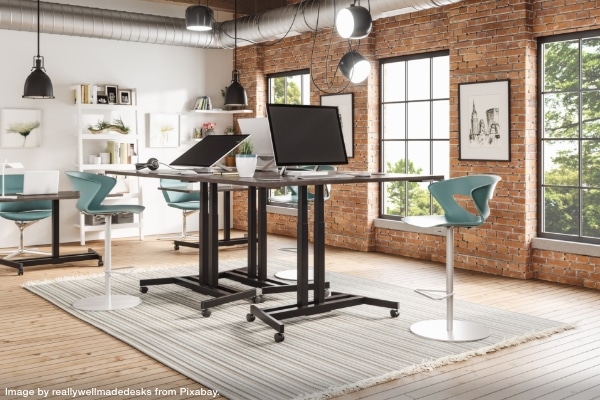
There appears to be a movement towards standing desks vs your traditional sit-down desks. But is this all hype, or is there substance to this movement? Standing desks have existed for centuries; notable users include Thomas Jefferson and Winston Churchill. Researchers are finding out that sitting might be too much of a good thing. It harms your health. When you slump in your chair:
- You burn one-third of the calories compared to walking
- Your metabolism drops
- You risk becoming obese
- Your chance of developing diabetes grows
A new study linking sitting and obesity by the American Cancer Society found that standing for at least a quarter of the day reduces the odds of obesity. Interestingly, these benefits are more noticeable for women than men. A simple solution would be simply sitting less. It sounds simple, but it is not that easy since there are other things to consider (according to the critics).
Prolonged sitting (and prolonged standing, for that matter) can cause health problems such as varicose veins. In addition:
- Your knees hurt
- You get distracted while constantly adjusting your posture
- Your feet start to feel numb
As researchers delve more into studying standing vs. sitting, they discover that walking is even more critical. They recommend that office workers stand and walk for at least two hours a workday and build up to four hours of walking.
How to Integrate Standing Desks into Your Daily Work Routine
- Use an anti-fatigue mat with your standing desk. These mats, usually made with a gel-type substance, support your feet and lessen the pressure on your body. As a result, it is easier to stand for long periods.
- Do simple exercises throughout the day. This can include taking the stairs instead of the elevator and holding meetings while you walk around the building instead of sitting in an office.
- Prioritize productivity by listening to your body. If you are straining to stand, it’s time to sit and rest before standing up again later. Likewise, if you find yourself slouching, it’s time to stand up for a while. Switch between sitting and standing throughout the day to keep you energized.
- Focus on ergonomics. Design your desk space to promote good posture, whether sitting or standing.
Benefits of Standing
- Reduced Risk of Obesity, Type 2 Diabetes, Cardiovascular Disease, Cancer, and Other Metabolic Problems
- Lower Long-Term Mortality Risk
- Increased Productivity
- Increased Focus and Concentration on Tasks
- Higher energy levels
Standing can give you a sense of urgency, causing you to focus on completing your tasks. You can see this effect when someone stands up as soon as you walk into their office. You tend to get straight to the point instead of having a more relaxed conversation. However, heavy thinking and creative projects may require you to be seated to be more productive. Standing during the day makes it easier to keep energy levels constant and avoid the 3 o’clock slump and the dreaded food coma. As a result, your mind won’t drift, your eyes won’t droop, and you can get through your day without experiencing an energy roller coaster.
Many studies have been conducted about sitting and standing workstations. Keeping the body in motion is the key to better health, so incorporate a standing desk into your office.
Image by reallywellmadedesks from Pixabay.
